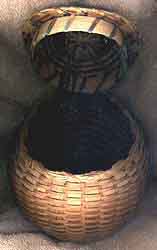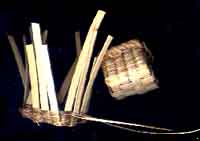
Braided Decorative Accent
 Brighter Colors Revealed Inside
Brighter Colors Revealed Inside
Sweetgrass Traditions
|
Though generally smaller than their woodsplint cousins, sweetgrass baskets
had a similar often dyed or swabbed ash splint spoke base. Long exposed to light and weather these
delicate baskets may seem to have lost their scent and have a faded exterior. However, a glimpse
beneath their lids into their protected interiors will often reveal a surprising
rainbow of colored splints. A misting with water is known to entirely restore their odorous scent.
 Braided Decorative Accent |  Brighter Colors Revealed Inside
Brighter Colors Revealed Inside
|
Sweetgrass blades were gathered, dried, then soaked again before use in basketry. The fine yet sturdy leaves can be individually twined, working in pairs, around the basket spokes, or the blades of grass could be braided together first and then woven onto the ash splints. Some of these braided ropes of sweetgrass were as thin as string, while others were more boldly braided into thicker ropes. In later times as an aid to increase production, many Natives began to incorporate imported Hong Kong cord in their sweetgrass baskets. This commercially available twisted cord completely supplants the use of sweetgrass in some baskets. As the pre-processed cord was not as popular in the market, it fell out of use with many weavers.
 Small Basket in Production
Small Basket in Production
| Because, like other special plants such as tobacco and cedar, sweetgrass has long standing traditional uses for medicine and ceremony it has always been afforded special respect and care; gifts and thanks are offered to gather or use it. |
Trudie Lamb Richmond, Schaghticoke, describes an interview with a modern Mohawk basket maker who uses sweetgrass. Trudie explains: "She told me she had thought about this meaning and that was why she always talked to her baskets as she made them. She said that she asked forgiveness for having to sell the baskets, but that she needed the money to survive. Using the sweetgrass would keep the baskets strong and alive, and she hoped that the people who bought them would appreciate their significance." (in McMullen & Handsman 1987)
 Baskets and Crafts
Baskets and Crafts
|
Medicine and Ceremony

|